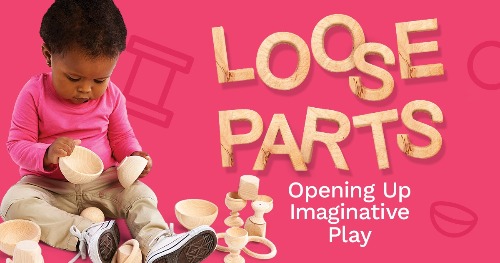Loose Parts: Opening Up Imaginative Play in Children

"Loose parts"—a buzzword in the field of early childhood education—are open-ended materials that do not have a specific purpose and, as such, can be manipulated, combined with other loose parts, used and re-used in a variety of ways. They can often be taken apart and put back together, for repeated enjoyment. By utilizing play materials in this way, children are able to innovate, invent, and create in as many ways as their imagination can come up with.
The best part? As children innovate, invent, and create, their imagination is expanded to promote even more ideas, as well as growth across developmental domains. Therefore, the possibilities with loose parts are infinite, leading to endless fun (as well as learning and growth) for our youngest minds.
Ideas for loose parts are unlimited, as children, with creativity and imagination so fresh, can turn anything into a toy. However, families and early childhood educators can get a head start on this by providing a variety of loose parts to children in order to enhance their play. These can include store bought materials, as well as found materials in the child’s environment.
Below are ideas for loose parts for young children (remember, for infants and toddlers, it is imperative that all toys that they interact with—including loose parts—be larger than the opening in a choke tube). For safety, ensure any loose parts are free of jagged edges and will not easily be broken into small pieces that could pose a danger.
Ideas for Loose Parts Play
Boxes
Boxes are perfect for building, climbing into and out of, for obstacle courses, and more.
-
Cardboard Tubes and Pieces
- Cardboard tubes and pieces of cardboard can be used for tunnels, ball mazes, telescopes, building materials, and art materials.
Empty Containers (and their lids, if applicable)
- Plastic containers are particularly excellent for practicing fine motor skills such as opening/ closing containers, filling and dumping, music making, holding other materials, and more.
-
Pots and Pans
- Virtually indestructible materials for banging, building, and music making!
-
Natural Objects
- Objects found in, or representative of, nature are:
- Dried leaves, acorns, sticks, or other plants especially lend themselves to sorting activities and art experiences (2D and 3D)
- Dried leaves, acorns, sticks, or other plants especially lend themselves to sorting activities and art experiences (2D and 3D)
- Rocks, Natural Sorting Stones (ages 2+) or Rainbow Pebbles are useful for sorting activities, sensory experiences, game play, stacking and more!
- A Natural Treasure Set (Ages 3+) - features a variety of responsibly collected found objects, providing endless opportunities for exploration
- Responsibly gathered Pinecones and Seed Pods (ages 3+) are excellent for comparing and contrasting, sorting, and arranging by size or other feature
- Tree Rings (ages 4+) help children with counting and observing differing and comparable characteristics, and can be exciting especially when enhanced with Branch Blocks (ages 3+) and Baby Tree Blocks (ages 12 months+) - both of which are exciting building materials on their own, as well!
-
Ways to Enhance Loose Parts Play
- When engaging in loose parts play, it is also imperative that the caregiver plays a supportive role in the child’s exploration, encouraging and enhancing the experience without taking over. This can be done in a number of ways, including:
- Join in on the child’s play, following their lead
- Occasionally ask open-ended questions; however, ensure that questioning does not interfere with time to play and explore. Some open-ended questions and comments that could be asked include:
- What would happen if….?
- What else could you try?
- How are [2+ items] the same? How are they different?
- Tell me about your structure.
- Observe the ways in which children utilize loose parts
- Ensure that children have a variety of loose parts that they can access and utilize independently.
Just remember: when encouraging and joining in on loose parts play with young children, come to it with a loose state of mind. This will ensure open and endless opportunities for creativity and learning.
You Might Also Like:
 Zaina Cahill, Early Childhood Education Policy Director at Children First, is a graduate of New York University (B.S. in ECE and Special Education) and Walden University (M.S.Ed. in Elementary Reading and Literacy), and has worked in a variety of capacities in the field of education working with toddler through elementary school children and their families, including children with special needs. In particular, Zaina has a passion for working to promote diversity, equity, and inclusion in the education environment. In Pennsylvania, Zaina holds Level 2 teaching certification in ECE, as well as PQAS (PA Quality Assurance System) certification to offer professional development. In addition, she is a certified CLASS observer (Infant, Toddler, PreK). Zaina is also adjunct faculty at Arcadia University, in the school’s graduate program for Early Childhood Education. Zaina is a member of the NAEYC Affiliate Advisory Council, the Exchange Leadership Institute, and the Philadelphia Race Matters and Cultural Competency Learning Circle. In 2016, Zaina was an honoree in attendance at the White House Teacher of the Year Event, hosted by Barack Obama, and has offered testimony in congressional hearings advocating for children and early childhood educators. In addition to presenting at various local, state, and national conferences, Zaina has also made a number of written contributions to blogs and education publications.
Zaina Cahill, Early Childhood Education Policy Director at Children First, is a graduate of New York University (B.S. in ECE and Special Education) and Walden University (M.S.Ed. in Elementary Reading and Literacy), and has worked in a variety of capacities in the field of education working with toddler through elementary school children and their families, including children with special needs. In particular, Zaina has a passion for working to promote diversity, equity, and inclusion in the education environment. In Pennsylvania, Zaina holds Level 2 teaching certification in ECE, as well as PQAS (PA Quality Assurance System) certification to offer professional development. In addition, she is a certified CLASS observer (Infant, Toddler, PreK). Zaina is also adjunct faculty at Arcadia University, in the school’s graduate program for Early Childhood Education. Zaina is a member of the NAEYC Affiliate Advisory Council, the Exchange Leadership Institute, and the Philadelphia Race Matters and Cultural Competency Learning Circle. In 2016, Zaina was an honoree in attendance at the White House Teacher of the Year Event, hosted by Barack Obama, and has offered testimony in congressional hearings advocating for children and early childhood educators. In addition to presenting at various local, state, and national conferences, Zaina has also made a number of written contributions to blogs and education publications.
